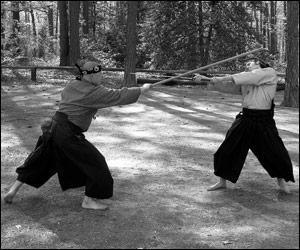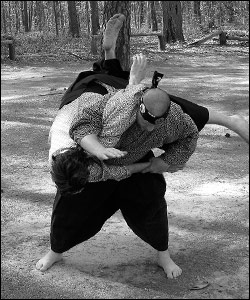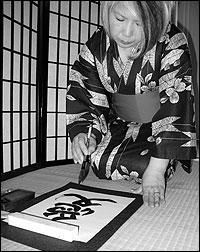The Seirin School of Classical Japanese Martial Arts
 The name "Seirin Dojo" means "training hall of the pure noble forest", and was established in 1993. The methods taught within the school are referred to as "Kobudo", or "old martial arts". The name of the school represents our strong bond with nature as living beings, and is located in Richmond, Virginia. The name "Seirin Dojo" means "training hall of the pure noble forest", and was established in 1993. The methods taught within the school are referred to as "Kobudo", or "old martial arts". The name of the school represents our strong bond with nature as living beings, and is located in Richmond, Virginia.
At the Seirin Dojo we provide training in some of the oldest forms of Japanese martial traditions, or "Koryu" (literally "old style"). The training practiced at the school focuses on developing the vital foundations of a good Martial Artist. These include physical fitness, body conditioning, mental acuity, spiritual toughness and an understanding of one's abilities and limitations.
Unlike many Martial Arts that rely mostly on physical strength and speed, Kobudo training focuses in equal parts on the understanding and importance of timing, distance, and strategy as well as physical and mental conditioning. Kobudo can be effectively practiced by the largest man as well as by the smallest woman, and is as relevant and effective today for all types of people as it was centuries ago.
In addition to the physical methods taught in the school, students of the Seirin Dojo recieve training in a variety of subjects related to Japanese martial arts practice and study. These include Japanese language, history, culture, philosophy in addition to practical methods of first-aid and survival. Class sizes are small, providing an excellent teacher-student ratio. Each year the school takes a small group to Japan to experience the culture and training from the source, providing a once in a lifetime experience.
Kobudo Arts
At the Seirin School, students train in several schools (Ryu-ha) of Kobudo, including several ancient martial traditions (Koryu). This is not a "sport" method of Martial Arts. Students do not participate in tournaments or other competitive activities. Students train to  prepare themselves for real-world conflicts of all kinds, with the intent of improving themselves and the world around them. prepare themselves for real-world conflicts of all kinds, with the intent of improving themselves and the world around them.
The term “Kobudo” is a rather general term that means “old warrior ways”, and is used to differentiate older, classical martial arts systems from modern, sportive methods (called “Gendai Budo”, or "modern martial ways"). The term “Kobudo” does not describe any particular martial art, though some individuals use it as such (many Okinawan Karate-do stylists use it to describe weaponry arts). A more descriptive term that better illustrates the type of martial arts training found in the Seirin Dojo would be “Koryu”. Koryu is comprised of two Kanji characters:
Ko/Furui - Classical, old, or ancient
Ryu/Nagare - Flow, flowing, school, lineage or tradition
When these two characters are joined they represent a classical school, old flow, or an old flowing tradition. Add this to "Bujutsu" or "Bugei" (both terms that mean “Warrior Art”) and you have a classical warrior/military art.
Kobudo arts are the root of all modern Japanese arts and includes the original, combat-oriented methods found in modern derivatives such as Judo, Kendo, Aikido, Karate-do and others. Kobudo training encompasses many different types of unarmed fighting skills (Jujutsu/Taijutsu), as well as a variety of armed forms of combat. These include blade arts (Tantojutsu/Kenjutsu/Iaijutsu/Battojutsu), halberd arts (Sojutsu/Naginatajutsu/Bisentojutsu), stick and staff arts (Rokushakubojutsu/Jojutsu/Sanjakubojutsu), projectile methods (Shurikenjutsu, Nagekenjutsu) and other classical Japanese arms.
Instruction is taken from the following schools of classical Japanese Kobudo:
• Gyokko Ryu Kosshijutsu
• Koto Ryu Koppojutsu
• Kukishinden Happo Hikenjutsu (Kukishin-Ryu) Dakentaijutsu
• Takagi Yoshin Ryu Jutaijutsu
• Shinden Fudo Ryu Dakentaijutsu • Jutaijutsu
The Seirin Dojo also offers specialized training exclusively for law enforcement, firefighters, security and military personnel, and others. Click here for more information on the program.
The Seirin Dojo Staff
Scott Takahashi
Head Instructor and Seirin Dojo-cho
Godan
Scott began his martial art training at the early age of ten, learning the Korean martial arts known as Chung Do Kwan and Moo Duk Kwan. He began studying Shito Ryu Karate-do in his early teenage years, developing a fascination with Japanese Budo. Yearning to learn more about the classical martial arts of old Japan, he started searching for an art that was not sport-oriented or modernized. At age fifteen he began his training in the classical Japanese Budo (Kobudo), attaining the rank of Godan (5th Degree Black Belt) In 1993. Shortly thereafter he opened his first formal Dojo and began actively teaching the Koryu arts. Scott has had the pleasure of training with the top Japanese master teachers in the art, in addition to training with prominent American instructors as well. He has had the pleasure of teaching law enforcement, military personnel, and firefighters and continues to work with those groups, in addition to teaching children, adults and seniors. Scott is a speaker of Japanese language, and maintains interests in many facets of Japanese culture, history and philosophy. These elements strongly influence his teaching style and methods. He returns to Japan on average of twice a year to further his own training with the Japanese masters and visit with his family, who reside in Shizuoka-ken, Japan (Mt. Fuji area). A native of New Jersey, he currently resides in Richmond, VA with his wife Kyomi, a native Japanese who is an accomplished Shodo artist (calligraphy arts) and a Japanese translator/interpreter. Scott and his wife Kyomi together run a Japanese translation business.
 George McDowell George McDowell
Assistant Instructor
Shodan
George McDowell is the head Assistant instructor in the Seirin Dojo, in addition to being the Senpai of the school (Senior-most student). He has over 10 years experience in the classical Budo, and currently retains the rank of First Degree Black Belt. He currently resides in Richmond, VA with his family, and works at a prominent media company in the city.
Kyomi Takahashi
Japanese Arts Director
Kyomi directs and develops the additional programs taught through the school, in addition to Japanese language tutoring. She is well known for her unique artistic style of Japanese calligraphy art (Shodo), and is the daughter of prominent Shodo artist Sueko Takahashi of Shizuoka-ken Japan.
|